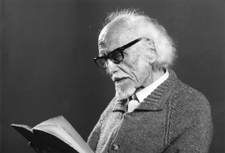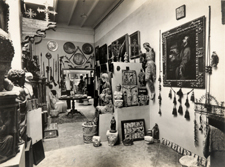


Frederic Marès i Deulovol (Portbou, 1893 - Barcelona, 1991) came to Barcelona with his family in 1903, when he was ten years old. He immediately started attending classes at the School of Fine Arts, La Llotja, where he received training as a sculptor, and where he would later work as a teacher until 1964.
Marès started working in the workshop of Art Nouveau sculptor Eusebi Arnau. His first monument in the city of Barcelona, located in Plaça del Clot and dedicated to Canon Rodó (1919), dates from this period.
In this stage, while Marès was still unknown, his output involved mainly both portraits and funeral sculptures, as well as a series of female nudes that enable us to categorise his work within the most characteristic features of Noucentisme.
However, Marès' fame as a sculptor is linked to his monumental sculpture, such as hissculptures Barcelona and Emporion, which decorate Plaça de Catalunya, the commemorative monument dedicated to theatre designer Francesc Soler i Rovirosa on Gran Via, and the monument to Francesc Layret in Plaça Goya, all these located in Barcelona.
After the Civil War, Marès' extensive, prolific post-war output focused on three spheres: monument restoration, especially the re-creation of the royal tombs from the church of the Poblet monastery started in 1944; official commemorative sculptures, such as the reclining statues of James I and James II in the cathedral of Mallorca; and religious sculpture, most particularly the decoration and statuary in the Sant Esteve church in Parets del Vallès.
However, in addition to being a sculptor, Marès also felt a passion for collecting from a tender age. He discovered the world of antiquarians and auctions in Paris back in 1911 and purchased his first collections. He gradually expanded them and gathered them in his sculpture workshop and at his home until in 1944 the Association of Friends of Catalan Museums held an exhibition with a selection from his collection at the City History Archive, and he publicly expressed his determination to donate his collection to the city.
The inauguration and gradual growth of the museum kept gaining momentum until collecting came to the fore of his activities and his personal dedication to sculpture gradually waned until he largely left it in the hands of his workshop.
Marès also had a prosperous career as a teacher, as he came to hold the posts of director of the School of Fine Arts and the School of Arts and Crafts in Barcelona, and even the presidency of the Sant Jordi Royal Catalan Academy of Fine Arts.